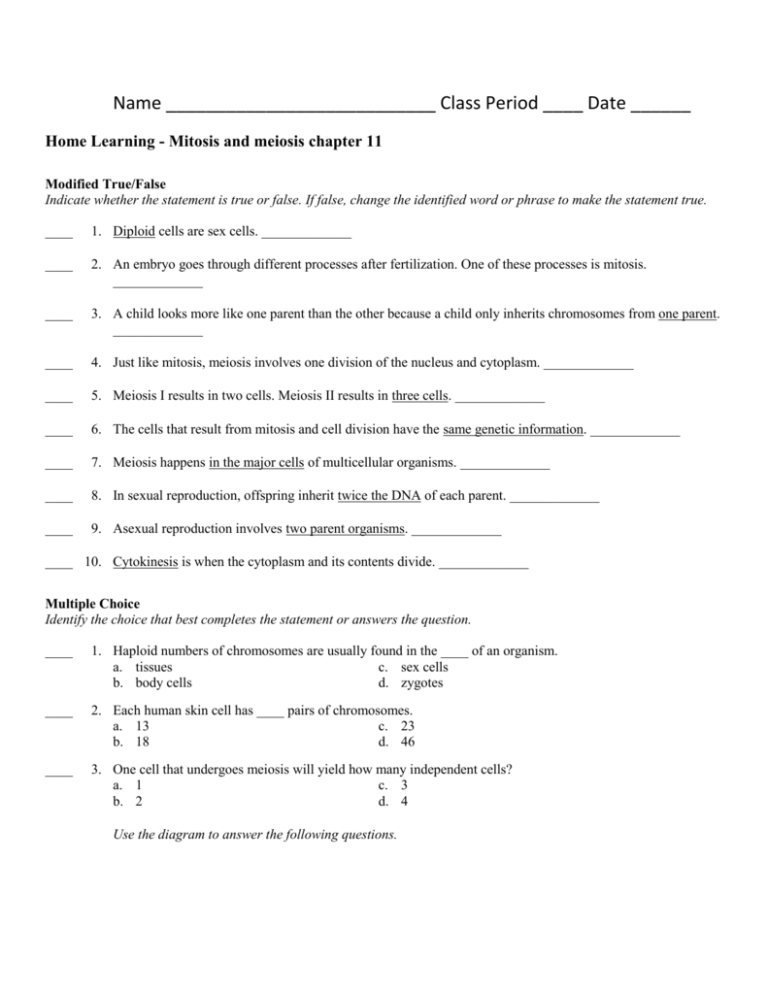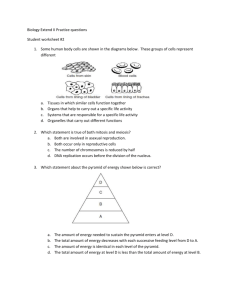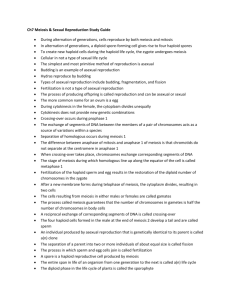Home Learning - Mitosis and meiosis chapter 11
advertisement

Name ___________________________ Class Period ____ Date ______ Home Learning - Mitosis and meiosis chapter 11 Modified True/False Indicate whether the statement is true or false. If false, change the identified word or phrase to make the statement true. ____ 1. Diploid cells are sex cells. _____________ ____ 2. An embryo goes through different processes after fertilization. One of these processes is mitosis. _____________ ____ 3. A child looks more like one parent than the other because a child only inherits chromosomes from one parent. _____________ ____ 4. Just like mitosis, meiosis involves one division of the nucleus and cytoplasm. _____________ ____ 5. Meiosis I results in two cells. Meiosis II results in three cells. _____________ ____ 6. The cells that result from mitosis and cell division have the same genetic information. _____________ ____ 7. Meiosis happens in the major cells of multicellular organisms. _____________ ____ 8. In sexual reproduction, offspring inherit twice the DNA of each parent. _____________ ____ 9. Asexual reproduction involves two parent organisms. _____________ ____ 10. Cytokinesis is when the cytoplasm and its contents divide. _____________ Multiple Choice Identify the choice that best completes the statement or answers the question. ____ 1. Haploid numbers of chromosomes are usually found in the ____ of an organism. a. tissues c. sex cells b. body cells d. zygotes ____ 2. Each human skin cell has ____ pairs of chromosomes. a. 13 c. 23 b. 18 d. 46 ____ 3. One cell that undergoes meiosis will yield how many independent cells? a. 1 c. 3 b. 2 d. 4 Use the diagram to answer the following questions. ____ 4. How are sex cells produced? a. haploid b. diploid c. meiosis d. mitosis ____ 5. What is the cell called that results from fertilization? a. egg c. zygote b. sperm d. diploid ____ 6. Which type of cells form through meiosis? a. sex cells b. body cells c. zygote cells d. epithelial cells ____ 7. How many cells are produced by mitosis and cell division? a. 0 c. 2 b. 1 d. 3 ____ 8. Which of the following is part of asexual reproduction? a. one parent organism c. meiosis b. two parent organisms d. fertilization ____ 9. Which of the following is NOT a form of asexual reproduction? a. budding c. animal regeneration b. vegetative reproduction d. meiosis ____ 10. This figure shows what type of asexual reproduction? a. budding b. vegetative reproduction c. animal regeneration d. meiosis Completion Complete each statement. 1. The process of nuclear division that produces haploid sex cells is ____________________. 2. Budding and regeneration are two types of ____________________ reproduction. 3. Sex cells differ from body cells in that they do not have ____________________ of chromosomes. 4. Sexual reproduction relies on meiosis instead of mitosis because only meiosis produces ____________________ sex cells. 5. Genetic __________ exists among all organisms that sexually reproduce.








